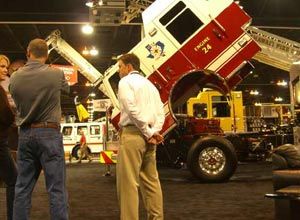
By Jerry Brant
 Photo Jamie Thompson |
| Related Resources: Stimulus funding: What you need to know CDBG program Web site |
This is a 27 percent increase over the previous year's allocation, according to John Laswick, a Community Development Specialist with the Department of Housing and Urban Development, which administers the program.
Since 1974, the CDBG program has provided grants to eligible units of general municipal government for a wide range of activities that facilitate revitalization of local communities. In recent years competition for these funds has intensified as needs have increased and other sources of funding have diminished. But fire and EMS departments have successfully accessed the program to assist them in financing a number of qualified projects.
Public services
Up to 15 percent of CDBG money may be used by municipalities for public services, which includes fire, police and EMS as well as areas such as daycare programs and public health centers. If you are interested in accessing this funding, you should initiate dialogue with your state, county, or local planning or development agencies without delay.
Because this program is being treated as an amendment to the community's existing action plan, the local municipality may not be required to hold public hearings on its intended use of these new funds. In other words, if you don't approach your local government with your new request it may simply develop its CDBG action plan amendment from leftover projects that could not be funded in the past.
Here's what you should be doing:
If this seems like a lot to accomplish in a short period of time, just consider it another normal day in the fire service. You can't afford to overlook this opportunity because I doubt that we will see anything like it in the near future.
Success story
One example of departments benefiting from the program in the past is the DuBois Fire Department in Pennsylvania. The department protects the city of DuBois, operating out of five stations with 462 volunteer firefighters.
"Over the years, the department has accessed the CDBG program to purchase new apparatus, to build new fire stations, and to buy new SCBA," said Mayor Herm Suplizio. The mayor knows first hand the difficulties volunteer departments have in raising sufficient funds; he is also a member of the DuBois Fire Department and served as its chief for two years.
The fire department and the city have a policy of replacing one of the department's six engines every five years. In order to accomplish this objective, a portion of each year's CDBG funds are designated for apparatus replacement.
Last year, the department bought a new engine that cost almost $500,000, with the majority of this money coming from the CDBG program. The mayor says the city has already completed its 2009 CDBG "action plan," and included in the proposal is funding for a new ramp at its Third Ward Fire Station. "CDBG has helped us to do a number of projects that we never would be able to do on our own," Mayor Suplizio said.
Copyright © 2024 FireGrantsHelp.com. All rights reserved.